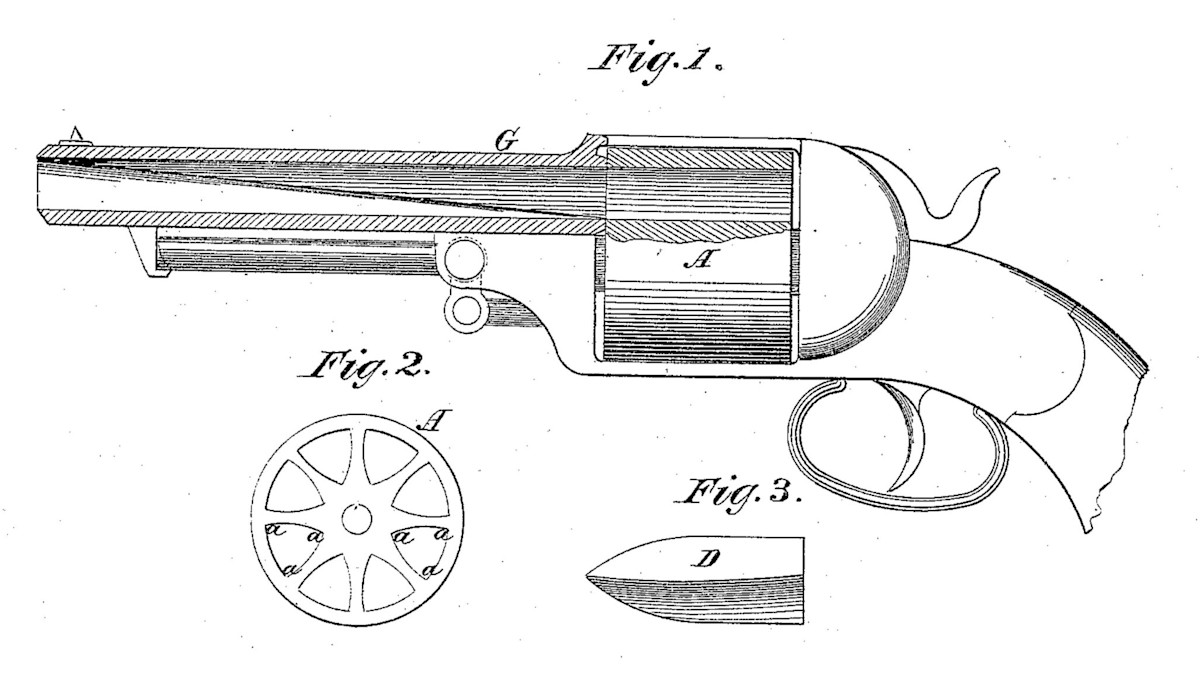
Whether used for war, self-defense, or hunting, guns that can stuff more cartridges into less space offer their users an advantage. That’s why Sig Sauer’s “high-capacity micro handgun,” the P365, was such a sensation when it dropped in 2017 and why other gun companies wasted no time mimicking their design.
As it turns out, gun owners in the 19th century weren’t so different from us. They also wanted higher capacity firearms that didn’t sacrifice weight or size, and gun designers offered a variety of crazy ways to fit more cartridges inside a revolver’s cylinder.
Otto Schneeloch was one such designer. He invented and patented a revolver that used triangular bullets shot through a triangular barrel. Organized like slices of pizza, these cartridges eliminated some of the space that circular cartridges waste in a cylinder. Based on what he said in his patent application, he believed his invention was successful.
“It has long been a desideratum with manufacturers to construct revolving fire-arms with the smallest volume in proportion to the weight and number of balls carried,” Schneeloch said. “This want is supplied by my invention, which lightens the arm while it increases its efficiency.”
The Triangle Gun
If you’re skeptical that a revolver could shoot triangle-shaped bullets from a triangle-shaped barrel, get in line. But Schneeloch wasn’t some crackpot inventor exploding things in his basement. He was an armorer in Germany before immigrating to New York City in 1856, and he’s listed as a gunsmith in New York in 1858, according to a thesis on the triangle gun by Amber Shukitis published by the University of South Florida (the historical information below largely comes from this thesis). Schneeloch’s two brothers worked at Winchester Company and Springfield Armory, so he would have had access to both materials and expertise to turn his triangle gun into a reality.

The idea was simple. Schneeloch wanted to create a revolver that fired a bullet of similar weight to a .32-caliber projectile while maintaining the capacity of a .22-caliber revolver. Triangular cartridges take up some of the real estate wasted by circular cartridges and allowed Schneeloch (theoretically, at least) to load heavier bullets while maintaining an eight-round capacity.
“By this construction a chamber will throw twenty-five per cent more balls of a given weight than one of the same size in which any other cross-sectional form is employed, and will also be considerably lighter,” he said in his patent application.
Unfortunately, Schneeloch never got a chance to test his idea in the real world. The only evidence that he ever created a working triangle gun comes from Lewis Winant’s reference book, “Firearms Curiosa.” The section includes an image of a prototype triangle gun, which appears to have been Frankensteined from several Smith & Wesson models in common use at the time. The prototype doesn’t appear to have a hammer, but the triangular cylinder and one triangular cartridge can be clearly seen. In a letter to the U.S. Patent Office, Schneeloch claims to have manufactured the cylinder himself.
Schneeloch tragically died before he got a chance to finish his prototype. He was an avid (and successful) competitive shooter, but that hobby turned out to be the death of him. On October 15, 1877, Otto Schneeloch was shot and killed by a careless companion during a shooting match at College Point, Long Island.
Bringing the Triangle Gun to Life
For most obscure and possibly impractical firearms, that would have been the end of the story. Schneeloch’s “.307 Triangular” languished in total obscurity until 2013, when a professor of mechanical engineering at the University of South Florida set out to recreate the unorthodox design. Dr. Stuart Wilkinson had always been a firearms enthusiast, and when he spotted the Triangular in “Firearms Curiosa,” he decided to finish what Schneeloch had started.
“Out of respect to a departed innovator, I felt it would be appropriate to tie up the loose ends and determine just how well his unique invention would have performed, using as authentic a recreation as possible,” he told MeatEater.
Working with Shukitis, who used the project as the subject for her thesis, he did just that. The 118-page document is incredibly detailed, and you can read it for yourself here. But we’ll hit the highlights.
Wilkinson’s first step was to work out the dimensions of Schneeloch’s triangular cartridge. Fortunately, while the prototype gun has been lost, three bullets and one case still exist. Wilkinson tracked down the man who had access to these bullets, and he supplied measurements and photos. Wilkinson and his student modeled the bullet and case using computer software and manufactured the components using materials that would have been common while Schneeloch was alive (the lead bullets, for example, were made from melted Civil War-era bullets).
Instead of trying to recreate the entire revolver, Wilkinson opted instead to manufacture a standalone barrel and a cylinder with a single chamber. He crafted a firing pin and trigger mechanism, and affixed all three components in a line. This device accurately recreated the ballistics of the .307 Triangular without adding the complexity (and cost) of too many moving parts.
Wilkinson told MeatEater that while the brass cases were challenging to manufacture, the barrel was the most difficult task.
“A custom rifling button was not feasible because of the gross metal movement in transitioning from a round bore to a triangular one,” he explained. “A broaching technique was probably used in making the original prototype, but this would have been a time-consuming and laborious task. So, an advanced metal 3D printing process was employed. This enabled the barrel to be built in stainless steel from a CAD model, with a curved-sided triangular bore and appropriate rifling twist.”
With the “gun” complete, it was time to head to the range.
At the Range
Wilkinson says he had no preconceived ideas about how his device would perform, but I sure did. Turns out, I was wrong (it’s been known to happen occasionally). The triangle-gun apparatus performed remarkably well.
The researchers secured their recreation using a Ransom Rest and set it up 10 feet in front of the target. They shot at both ballistics gel and a bullseye, and recorded the velocities. The triangular bullets traveled significantly slower than the .22 Short they used as a comparison, but the heavier bullets produced nearly as much energy. They were also more consistent, producing a standard deviation in velocity of 26 feet-per-second (fps) as compared to the .22 Short’s 32 fps.
The triangular bullets traveled about 5.5 inches into the ballistics gelatin and stayed intact with no sign of fragmentation. What’s more, the channel in the ballistics gel indicates that the bullet was spinning, not tumbling. A high-speed camera would be needed to confirm the rotation of the bullet, but, according to Wilkinson, each vertex of the bullet cut a visible helical path.
Accuracy testing also indicated that the bullets were at least somewhat stable. The recreated handgun did not have sights, so the researchers had to aim by peering through the barrel at the target. But even given this imprecise method of aiming, the firearm produced a four-shot 1.67-inch group from 10 feet away. While this is no great shakes by modern standards, the holes in the paper appear to show that the bullets were flying nose-first rather than tumbling.
Last Shot
Wilkinson’s recreation was by all accounts a success, but you shouldn’t expect Sig Sauer, Ruger, or Smith & Wesson to release their own triangle guns any time soon. Wilkinson said that modern manufacturers could easily create a complete revolver, but he cautions against it.
“The triangular barrel bore and cylinder chambers would be inherently weak because of the stress concentrations at the apex points,” he said. “It is likely that such a firearm would suffer from gas sealing issues, since a triangular bullet does not obturate well into the triangular bore and such brass cases would tend to crack upon expansion in the chambers.”
Schneeloch’s design may not have a practical application, but as with other quirky chapters in firearms history, it demonstrates the commendable desire to innovate, experiment, and make things better. Sometimes those inventions don’t work out, but they nearly always inspire others.
About 80 years after Schneeloch’s .307 Triangular patent, another inventor named David Dardick submitted an idea for a firearm he named after himself. The .38-caliber “Dardick” used triangular shells (called “Trounds”) that contained traditional bullets, and fed these shells through a revolving cylinder. Though it’s unclear whether Dardick had heard of Schneeloch’s design, his idea was the same: triangles use space more efficiently than circles.
Though not commercially successful, the Dardick got farther than the .307 Triangular. It was sold at gun shops for a time, and working firearms still exist. It’s anyone’s guess whether the next experiment in triangular bullets will move the ball farther down the field, but whatever 21st-century gun designers come up with, I’m here for it.
Feature Image: Schneeloch’s patent/public domain.




